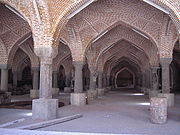
Shabestan
Encyclopedia

Iran
Iran , officially the Islamic Republic of Iran , is a country in Southern and Western Asia. The name "Iran" has been in use natively since the Sassanian era and came into use internationally in 1935, before which the country was known to the Western world as Persia...
).
These spaces were usually used during summers and could be ventilated by windcatcher
Windcatcher
A windcatcher is a traditional Persian architectural device used for many centuries to create natural ventilation in buildings. It is not known who first invented the windcatcher, but it still can be seen in many countries today. Windcatchers come in various designs: uni-directional,...
s and qanat
Qanat
A qanāt is a water management system used to provide a reliable supply of water for human settlements and irrigation in hot, arid and semi-arid climates...
s.
Moreover, during the Sassanid era and subsequent Islamic periods, shabestans were also referred to inner sanctums of Shah
Shah
Shāh is the title of the ruler of certain Southwest Asian and Central Asian countries, especially Persia , and derives from the Persian word shah, meaning "king".-History:...
s, where their concubines resided. Later these structures came to be called zanāneh (feminine residence), andarouni (inner private zone) and haram (from Arabic harem
Harem
Harem refers to the sphere of women in what is usually a polygynous household and their enclosed quarters which are forbidden to men...
).
Cooling
A shabestan can be cooled using a QanatQanat
A qanāt is a water management system used to provide a reliable supply of water for human settlements and irrigation in hot, arid and semi-arid climates...
in conjunction with a wind tower. A wind tower is a chimney-like structure positioned above the house; the one of its four openings opposite the wind direction is opened to move air out of the house. Incoming air is pulled from a qanat below the house. The air flow across the vertical shaft opening creates a lower pressure (see Bernoulli effect
Bernoulli's principle
In fluid dynamics, Bernoulli's principle states that for an inviscid flow, an increase in the speed of the fluid occurs simultaneously with a decrease in pressure or a decrease in the fluid's potential energy...
) and pulls cool air up from the qanat tunnel below the house. The air from the qanat was drawn into the tunnel at some distance away and is cooled both by contact with the cool tunnel walls/water and by the giving up latent heat
Latent heat
Latent heat is the heat released or absorbed by a chemical substance or a thermodynamic system during a process that occurs without a change in temperature. A typical example is a change of state of matter, meaning a phase transition such as the melting of ice or the boiling of water. The term was...
of evaporation as water evaporates into the air stream. In dry desert climates this can result in a greater than 15 C° reduction in the air temperature coming from the qanat. Wind tower and qanat cooling have been used in desert climates for over 1000 years.

